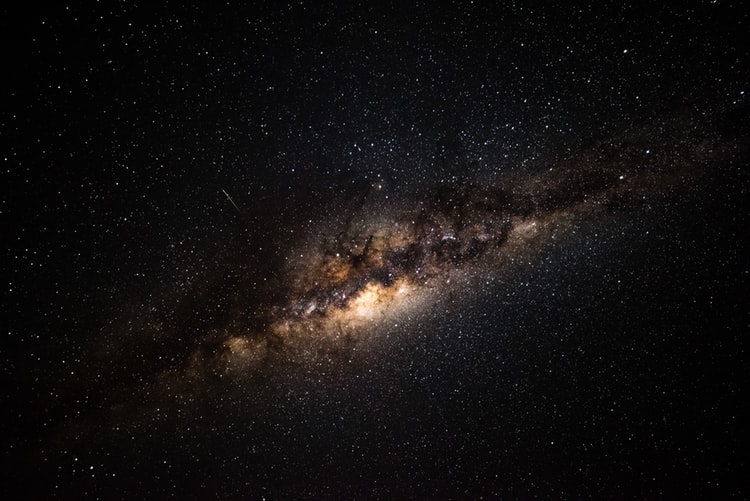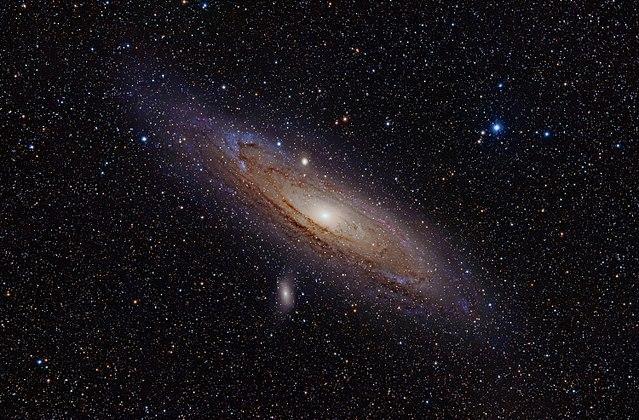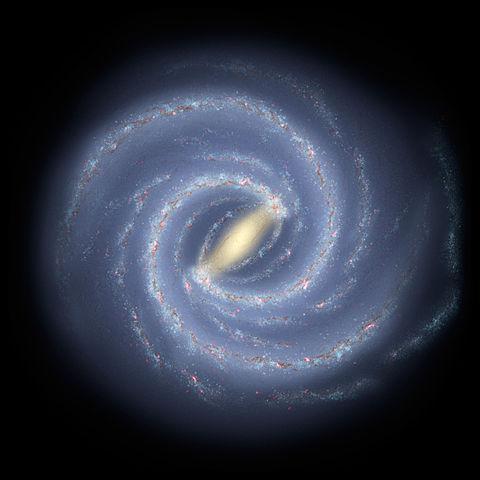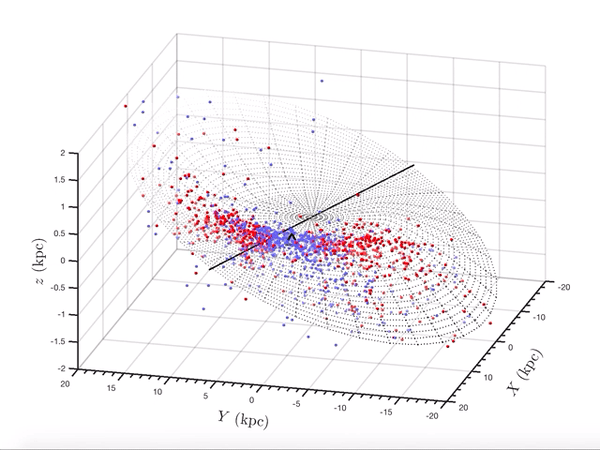The Milky Way

Milky Way galaxy as seen from Australia (Brett Ritchie via Unsplash)

Milky Way galaxy as seen from Australia (Brett Ritchie via Unsplash)
How does this align with my curriculum?
| Grade | Course | Topic |
|---|
In 2019, scientists discovered that our galaxy, the Milky Way, is not the shape they thought it was. How do astronomers use astronomical distance to understand the shapes of galaxies?
Have you looked up at a moonless night sky and noticed a band of stars snaking across? That’s the Milky Way, our home galaxy. The Earth, our Sun and every other star you can see are all inside the Milky Way.
From Earth, we cannot see the full shape of the Milky Way. For a long time, people believed the Milky Way was shaped like a pancake. But astronomers have new data that puts a twist in the shape of our galaxy - literally!
Did you know?
Because of light pollution, over one-third of the people on Earth can no longer see the Milky Way.

What is a galaxy?
A galaxy is made up of stars, planets and clouds of hydrogen gas. Most galaxies have more stars in their centres and fewer towards their edges. The closer a star is to the centre of a galaxy, the stronger the force of gravity it feels. The force of gravity is like the glue holding the galaxy together. This is the same force that makes your pencil fall to the ground.
Where in the Milky Way are we?
Our solar system is in the Orion Spur of the galaxy, a quiet suburb some 26 000 light-years from the galaxy’s centre. A light-year is the distance travelled by light in one year. At the speed of light, you could travel between Halifax and Vancouver 48 times in 1 second!
What shape is the Milky Way?
Did you know that galaxies come in various shapes? They may be spiral or elliptical (oval). If you’ve seen telescope photos of other galaxies like the Andromeda galaxy, you may have noticed their bright centre. That brightness is caused by the stars in that region. You may have also noticed their pancake-like shape.

If you look closely at the Milky Way with a telescope, you will see a band of stars with a bulge in the centre. If you look at a pancake from the edge, you see something similar. Astronomers measured the speeds and distances of several stars to find the shape of this disc. It turns out that shape is a spiral.

Imagine trying to draw an outline of Canada based on what you can see from your bedroom window. This would be very difficult, because you would not see very much! Astronomers trying to map the Milky Way have a similar problem. Figuring out the shape of the Milky Way is difficult because our sun, the Earth and every space probe we have are inside it.
Now imagine you were standing on a mountain and could see lighthouses far away. You could use the lighthouses on the Canadian coast to draw the shape of Canada. Of course, your shape would not be totally accurate. First of all, you wouldn’t be able to see every lighthouse from where you are standing. Also, places might not have lighthouses at all. For these places, you’d have to guess what their shape might be.
Astronomers used a similar technique to figure out the shape of the Milky Way. Of course, they didn’t use lighthouses. They used special stars called Cepheid variables. Astronomers calculated the distances to 1339 Cepheid variables. Then, they plotted the locations and distances of these stars on a 3D map.
This 3D map shows that our Milky Way is not a flat pancake! It’s more of a spiral pancake with one edge pulled up and the opposite edge pulled down. The further out from the centre you go, the more of a twist there is. You can see an animation of this at this link.

Is the Milky Way’s shape unique?
Astronomers know about other galaxies that are shaped like a bent spiral, though it appears this shape is rare. Astronomers don’t know the reason for the bent spiral, but they have some ideas. It might be the pull from the stars in the centre of our galaxy. Maybe smaller galaxies merged with ours in the past.
This time, astronomers found a twist in the Milky Way’s shape. As astronomers continue to map out more Cepheid stars, they may find “twists” in our understanding of the Milky Way, too!
Starting Points
- Have you ever seen the Milky Way on a dark, clear night? What shape did it appear to be?
- Would you like to be an astronomer? Why or why not?
- What environmental factors can influence our views of space from Earth?
- Should communities limit the amount of light that they produce at night? Why/why not?
- How important do you think the creation of dark sky preserves, areas that restrict artificial light pollution, are? Why are dark sky preserves created?
- Define a light year.
- What is the Milky Way? Where is Earth located within the Milky Way?
- What are Cepheid variables? How are they used to study the Milky Way?
- What is the shape of the Milky Way? How does the force of gravity affect the shape of the Milky Way?
- What theories do astronomers have regarding the twisted shape of the Milky Way?
- Conduct additional research to explore the different shapes of galaxies.
- Why is mathematics essential to the study of the Milky Way and other galaxies?
- In what forms of media have you heard the most about galaxies? Provide specific examples. How has this media shaped your ideas and understanding about galaxies?
- This article can be used for Grade 6 and Grade 9 Space for teaching and learning related to galaxies and astronomical distances. Concepts introduced include Milky Way, galaxy, stars, planets, hydrogen gas, force of gravity, solar system, light year, elliptical, Andromeda Galaxy and Cepheid variables.
- After reading this article, teachers could have students complete a Concept Definition Web learning strategy to consolidate their understanding of the concept of galaxies. Ready-to-use Concept Definition Web reproducibles are available in [Google doc] and [PDF] formats.
- Teachers can use the Question-Answer Relationship learning strategy to have students generate questions about how scientists calculated the shape of the Milky Way. Sample questions for this strategy could include:
- Search: What did astronomers search for to help them calculate the shape of the Milky Way?
- Explain: How did astronomers determine the shape of the Milky Way?
- Connect: Are any other known galaxies shaped like the Milky Way?
- Relate to Self: What do you feel when you look up at a clear night sky?
- Ready-to-use Question-Answer Relationship reproducibles are available in [Google doc] and [PDF] formats.
Connecting and Relating
- Have you ever seen the Milky Way on a dark, clear night? What shape did it appear to be?
- Would you like to be an astronomer? Why or why not?
Relating Science and Technology to Society and the Environment
- What environmental factors can influence our views of space from Earth?
- Should communities limit the amount of light that they produce at night? Why/why not?
- How important do you think the creation of dark sky preserves, areas that restrict artificial light pollution, are? Why are dark sky preserves created?
Exploring Concepts
- Define a light year.
- What is the Milky Way? Where is Earth located within the Milky Way?
- What are Cepheid variables? How are they used to study the Milky Way?
- What is the shape of the Milky Way? How does the force of gravity affect the shape of the Milky Way?
- What theories do astronomers have regarding the twisted shape of the Milky Way?
- Conduct additional research to explore the different shapes of galaxies.
Nature of Science/Nature of Technology
- Why is mathematics essential to the study of the Milky Way and other galaxies?
Media Literacy
- In what forms of media have you heard the most about galaxies? Provide specific examples. How has this media shaped your ideas and understanding about galaxies?
Teaching Suggestions
- This article can be used for Grade 6 and Grade 9 Space for teaching and learning related to galaxies and astronomical distances. Concepts introduced include Milky Way, galaxy, stars, planets, hydrogen gas, force of gravity, solar system, light year, elliptical, Andromeda Galaxy and Cepheid variables.
- After reading this article, teachers could have students complete a Concept Definition Web learning strategy to consolidate their understanding of the concept of galaxies. Ready-to-use Concept Definition Web reproducibles are available in [Google doc] and [PDF] formats.
- Teachers can use the Question-Answer Relationship learning strategy to have students generate questions about how scientists calculated the shape of the Milky Way. Sample questions for this strategy could include:
- Search: What did astronomers search for to help them calculate the shape of the Milky Way?
- Explain: How did astronomers determine the shape of the Milky Way?
- Connect: Are any other known galaxies shaped like the Milky Way?
- Relate to Self: What do you feel when you look up at a clear night sky?
- Ready-to-use Question-Answer Relationship reproducibles are available in [Google doc] and [PDF] formats.
Learn more
Why is the solar system flat? (2014)
Short video (3:11 min.) from Minute Physics showing how matter clumps together for stars and planets to form.
Final Frontier - The Milky Way is Warped (2019)
Video from (3:53 min.) from Expresso Show with astrophysicist Imogen Wotten, who describes how there's more to the shape of our galaxy than we thought.
New 3D map of the Milky Way shows we live in a warped galaxy (2019)
Article by David Freeman for NBC News MACH explaining how astronomers use newly-published data to accurately map the shape of our galaxy.
First accurate 3D map of the Milky Way reveals a warped galaxy (2019)
Articcle on Science Daily discussing how researchers explain how their work provides new insights into the formation of the Milky Way.
The Milky Way Is Warped in More Ways Than One (2019)
Article from Sky & Telescope on how Xiaodian Chen from the Chinese Academy of Sciences describes his group's work mapping the shape of our galaxy.
How Do We Know The Milky Way Is A Spiral Galaxy? (2018)
ScienceABC gives a short overview of efforts to discover the shape of the Milky Way.
For many the milky way Is out of sight (2016)
An audio clip (9:31 min.) from CBC Radio on light pollution in Canada.
References
Chen, X., Wang, S., Deng, L., de Grijs, R., Liu, C., Tian, H. (2019). An intuitive 3D map of the galactic warp’s precession traced by classical cepheids. Nature Astronomy, 3, 320-325. DOI: 10.1038/s41550-018-0686-7